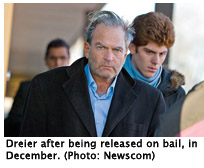The Impersonator
by Robert Kolker
New York Magazine
April 3, 2009
The whole operation was audacious to the point of sheer recklessness””from the start, he was just one due-diligence phone call from being found out””yet the very boldness of his plan was central to its success. Who would believe that such a respected and apparently successful attorney would knowingly peddle hundreds of millions of dollars worth of nothing?
 Like Bernie Madoff, Marc Dreier bilked unsuspecting investors out of many millions of dollars. But Dreier did it with flair.
Like Bernie Madoff, Marc Dreier bilked unsuspecting investors out of many millions of dollars. But Dreier did it with flair.
There was a time when Marc Dreier thought he could talk his way out of anything. But by last fall, even he was scrambling. Whenever the stylish, hyperaggressive 58-year-old white-collar litigator turned around, clients and colleagues at Dreier LLP, the marquee Park Avenue firm he”™d built from almost nothing to 250 lawyers in just five years, were asking questions””about back rent, unpaid loans, depleted client escrow funds, documents of uncertain provenance. What Dreier needed to make these questions go away, he knew, was money. About $40 million, for starters.
On Tuesday, December 2, Dreier boarded a private jet and flew to Toronto. When he landed, a driver brought him to the financial district and pulled up to the stout, glass-encased Xerox Tower. Dreier climbed out of the car and walked into the building. He was expensively dressed, but short and perma-tanned, with a thatch of gray hair swept over a sizable bald spot. He rode the elevator to the third-floor offices of the $100 billion Ontario Teachers”™ Pension Plan, one of the largest retirement funds in Canada. Dreier had arranged a meeting with one of the plan”™s in-house lawyers, Michael Padfield, ostensibly to discuss business opportunities. But Dreier had other motives, and the meeting lasted only briefly. Before saying good-bye, Dreier asked for a place to wait until his plane was ready. He was sure to take Padfield”™s business card.
Dreier dropped his things in a conference room, then went to the lobby, where he paced for an hour and eyed the entrance, until he spotted Howard Steinberg, an executive with a $34 billion New York hedge fund named Fortress. Steinberg and Dreier had never met, but they had been in touch earlier, when Steinberg had been trying to confirm the authenticity of some documents Dreier had sent him, promissory notes said to be worth $44.7 million that Dreier was offering to sell to Steinberg. When Dreier had told Steinberg the notes were guaranteed by the Ontario Teachers”™ Pension Plan, Steinberg had asked to meet with someone from the fund personally. Dreier told Steinberg he”™d arrange a meeting with Michael Padfield.
Dreier worked Padfield”™s business card into Steinberg”™s hand. Upstairs in the conference room, Dreier showed Steinberg some papers signed in Padfield”™s name. But the meeting didn”™t go as planned; Steinberg sensed something was off, and Dreier ended the meeting abruptly and went straight for the elevator. When he was gone, Steinberg approached the receptionist and asked her a simple question.
“Was that Michael Padfield?”
“No,” said the receptionist, “it wasn”™t.”
We live in an age of white-collar villains. But of all the financial bad guys out there, Marc Dreier is arguably the single greatest character of them all. Bernie Madoff may have stolen more money. Dick Fuld may have caused more systemic damage. But it”™s Dreier alone whose story reads like the stuff of Hollywood. Dreier isn”™t just accused of swindling more than $400 million from thirteen hedge funds. Prosecutors say he carried out the deception by inventing $700 million in financial assets out of whole cloth, staging fictional conference calls, and impersonating executives, sometimes personally, sometimes with the help of an associate, all while snapping up Warhols and waterfront homes, partying with pop stars and football players, and chasing an endless parade of much-younger women. He also allegedly stole some $40 million from his clients”™ escrow accounts, a brazen legal sin. Unlike Madoff, who worked from behind the scenes in the Lipstick Building, Dreier took a starring role in his own financial drama. Where Madoff was outwardly quiet and self-effacing, Dreier was openly egotistical, even smug. He seemed to think he could lie to his victims”™ faces and get away with it, to thrill, even, in the art of deceiving people. It”™s been suggested that Bernie Madoff was a pathological liar. With Marc Dreier, there appears to be little doubt.
Read the rest of the article here.
